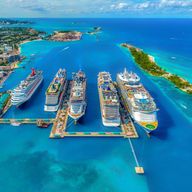

Seabourn Ovation - 5/8/2027
The May 8, 2027 cruise on the Seabourn Ovation departs from Civitavecchia (Rome), Italy. On this 7 Night Italy Malta Croatia & Montenegro (Rome To Dubrovnik) sailing, the ship will visit a total of 7 cruise port destinations, including its departure port. The Seabourn Ovation sets sail on Saturday, May 8th and returns on Saturday, May 15th.
Cruise Pricing
The graph below tracks historic price of the Seabourn Ovation cruise ship departing May 8, 2027. The most recent price for this sailing starts at $N/A ($N/A per night) for an Inside Cabin. Compared to the average price of $N/A ($N/A per night), this represents a recent decrease of NaN%.
Use the buttons below to toggle between cabin types.
Cruise Itinerary
Itinerary
Seabourn Ovation - May 8, 2027 - 7 Nights
| Day | Date | Port |
|---|---|---|
| 1 | May 8th | Civitavecchia (Rome), Italy |
| 2 | May 9th | Salerno (naples), Italy |
| 3 | May 10th | Giardini Di Naxos (taormina), Sicily |
| 4 | May 11th | Valletta, Malta |
| 5 | May 12th | At Sea |
| 6 | May 13th | Korcula Island, Croatia |
| 7 | May 14th | Kotor, Montenegro |
| 8 | May 15th | Dubrovnik, Croatia |
The Seabourn Ovation sails on May 8, 2027 for a 7 Night Italy Malta Croatia & Montenegro (Rome To Dubrovnik). The ship will depart the port of Civitavecchia (Rome), Italy at 6:00 PM and will return to the port of Dubrovnik, Croatia on May 15th at 7:00 AM. During the 8-day journey, the Seabourn Ovation will visit 6 additional ports and will spend 1 days at sea.
Cruise Ship

Seabourn Ovation
Seabourn Cruise Line
The Seabourn Ovation was built in 2018 and is among Seabourn's 5 ships in its fleet. The Seabourn Ovation is included in the cruise line's Encore class. In the cruise ship stats below, you'll find the Seabourn Ovation vs all other Seabourn ships.
Cruise Ports
Civitavecchia (Rome), Italy, offers docking at Civitavecchia Port with excursions to Rome. Travelers explore Colosseum and Pantheon. Excursions visit Vatican City’s Sistine Chapel. Local markets sell gelato. The peak season, April to October, brings warm weather for city tours. Photography captures ancient ruins and Tyrrhenian vistas. Dining onboard includes carbonara, an Italian favorite. Souvenirs, like Murano glass, are sold in ship shops. Briefings cover Roman history. Light clothing and sun protection suit the Mediterranean climate, while comfortable shoes enhance historic walks. Civitavecchia’s cultural gateway offers a vibrant Italian stop. Cruise travelers enjoy a mix of ancient landmarks and scenic coasts, making Civitavecchia an engaging destination. (126 words)
Salerno (Naples), Italy, offers docking at Salerno Port with excursions to Naples. Travelers explore Pompeii’s ruins and Amalfi Coast villages. Excursions visit Capri’s Blue Grotto. Local markets sell limoncello. The peak season, April to October, brings warm weather for coastal tours. Photography captures ancient ruins and Tyrrhenian vistas. Dining onboard includes pizza margherita, a Neapolitan favorite. Souvenirs, like ceramic crafts, are sold in ship shops. Briefings cover Roman history. Light clothing and sun protection suit the Mediterranean climate, while comfortable shoes enhance ruin walks. Salerno’s historic allure offers a vibrant Italian stop. Cruise travelers enjoy a mix of archaeological sites and coastal beauty, making Salerno an engaging gateway to Naples.
Giardini di Naxos, Sicily, has docking at Giardini Naxos Port with excursions to Taormina. Travelers explore Taormina’s Greek Theatre and Mount Etna views. Excursions visit Castelmola’s hilltop village. Local markets sell cannoli. The peak season, May to September, brings warm weather. Photography captures ancient ruins and volcanic landscapes. Dining onboard includes pasta alla Norma, a Sicilian dish. Souvenirs, like ceramic tiles, are sold in ship shops. Briefings cover Sicilian history. Light clothing suits the Mediterranean climate. Sturdy shoes enhance ruin walks. Giardini di Naxos’ scenic beauty offers a vibrant Sicilian stop, blending ancient heritage with coastal charm.
Valletta, Malta, offers docking at Valletta Port. Travelers explore St. John’s Co-Cathedral and Upper Barrakka Gardens. Excursions visit Mdina’s medieval walls. Local markets sell pastizzi. The peak season, April to October, brings warm weather for coastal tours. Photography captures Baroque architecture and Mediterranean vistas. Dining onboard includes rabbit stew, a Maltese favorite. Souvenirs, like lace crafts, are sold in ship shops. Briefings cover Knights of Malta history. Light clothing and sun protection suit the Mediterranean climate, while comfortable shoes enhance historic walks. Valletta’s cultural charm offers a vibrant Maltese stop. Cruise travelers enjoy a mix of UNESCO landmarks and scenic harbors, making Valletta an engaging destination. (126 words)
Take advantage of the many on board activites during your day at sea. You'll have more than enough to fill your day!
Korcula Island, Croatia, has docking at Korcula Port. Travelers explore Marco Polo’s alleged birthplace and St. Mark’s Cathedral. Excursions visit Vela Luka’s olive groves. Local markets sell grk wine. The peak season, May to September, brings warm weather. Photography captures medieval walls and Adriatic seas. Dining onboard includes pasticada, a Dalmatian dish. Souvenirs, like lavender sachets, are sold in ship shops. Briefings cover Dalmatian history. Light clothing and sun protection suit the Mediterranean climate. Comfortable shoes enhance old town walks. Korcula’s historic allure offers a vibrant Croatian stop, blending heritage with island beauty.
Kotor, Montenegro, offers docking at Kotor Port. Travelers explore Old Town walls and St. Tryphon Cathedral. Excursions include hiking Lovćen National Park. Local markets sell njeguški pršut. The peak season, May to September, brings warm weather for coastal tours. Photography captures medieval alleys and Adriatic vistas. Dining onboard includes cicvara, a Montenegrin favorite. Souvenirs, like olive wood crafts, are sold in ship shops. Briefings cover Illyrian history. Light clothing and sun protection suit the Mediterranean climate, while sturdy shoes enhance fortress hikes. Kotor’s historic charm offers a vibrant Montenegrin stop. Cruise travelers enjoy a mix of UNESCO landmarks and scenic bays, making Kotor an engaging destination. (126 words)
Dubrovnik, Croatia, offers docking at Gruž Port. Travelers explore Old Town walls and Lokrum Island. Excursions include kayaking along Adriatic shores. Local markets sell travarica. The peak season, May to September, brings warm weather for coastal tours. Photography captures medieval ramparts and Adriatic vistas. Dining onboard includes pašticada, a Croatian favorite. Souvenirs, like lace crafts, are sold in ship shops. Briefings cover Dalmatian history. Light clothing and sun protection suit the Mediterranean climate, while sturdy shoes enhance wall walks. Dubrovnik’s historic charm offers a vibrant Croatian stop. Cruise travelers enjoy a mix of UNESCO landmarks and scenic coasts, making Dubrovnik an engaging destination for exploration. (126 words)